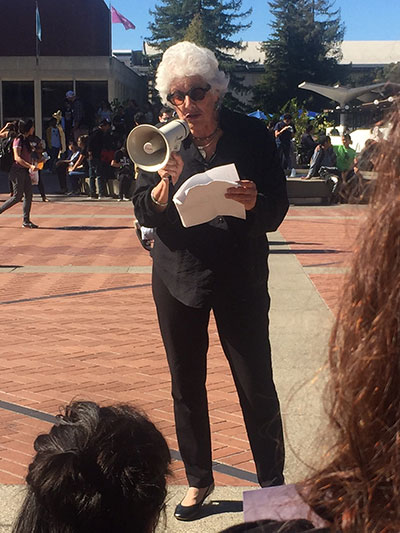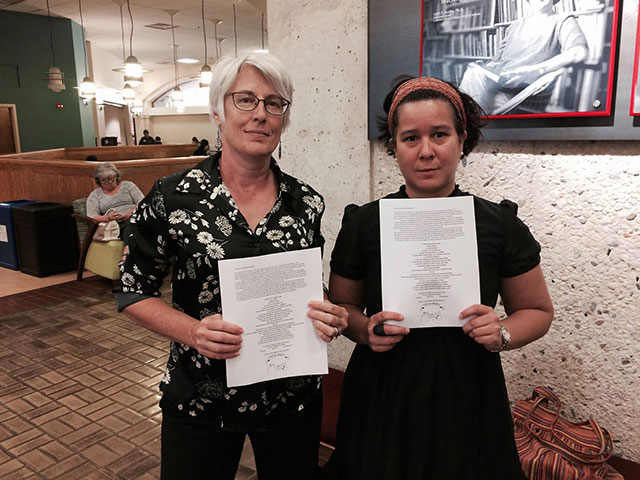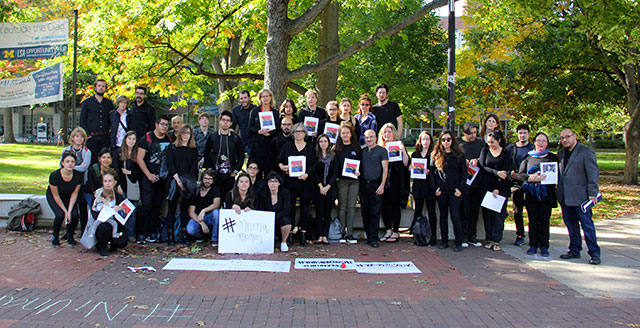
The October 19 strike was a powerful first: Thousands of women across Latin America, from Argentina to Mexico, interrupted their daily routines to take to the streets and plazas and join the first women’s strike in the region. Bringing together their voices, bodies and minds, they chanted “ni una menos” (not one less), “vivas nos queremos” (we want us alive) and “nosotras paramos” (we strike). With these words, the protesters demanded an end to the femicides and all violence against women around the world, especially in Latin America. In Argentina, every 30 hours a woman is murdered, and many others are beaten, raped, disappeared. The situation isn’t better in countries like Mexico, Chile, Ecuador and Perú.
The femicide of Lucía Perez, a 16-year-old Argentinean teenager who was brutally raped and murdered this month in Mar del Plata, shocked not only the Argentinean but also the broader Latin American community. The femicide was particularly brutal: Perez died from severe internal injuries after a gang allegedly drugged her, raped her and impaled her on a wooden spike. This specific case was the trigger for organizing national strikes in Argentina and Mexico; soon after, many others from countries across the continent joined this effort in order to protest against violence against women everywhere.
 Professor Francine Masiello reading a text by Andrea Jeftanovic at the demonstrations in UC Berkeley. (Photo: Félix Treviño)Sharing the belief that if “they strike one, they strike us all” we, a group of Latin American scholars living in the US, wanted to join the strikes in a common call, a common rage. We invited our fellow women compañeras, students, friends and workers to leave their offices, classrooms, hospitals, stores, factories and homes, to leave their reading and their writing. Wherever they were and whatever they were doing, we called them to join us in demanding, “Stop gender violence: we want ourselves alive!“
Professor Francine Masiello reading a text by Andrea Jeftanovic at the demonstrations in UC Berkeley. (Photo: Félix Treviño)Sharing the belief that if “they strike one, they strike us all” we, a group of Latin American scholars living in the US, wanted to join the strikes in a common call, a common rage. We invited our fellow women compañeras, students, friends and workers to leave their offices, classrooms, hospitals, stores, factories and homes, to leave their reading and their writing. Wherever they were and whatever they were doing, we called them to join us in demanding, “Stop gender violence: we want ourselves alive!“
This chant that emerged from the movements in Mexico was also sung at our demonstrations. To us, the phrase exposes and condemns the precariousness that threatens women’s bodies and lives within the patriarchal structures of our societies, where femicides are the most extreme inscription of a pervasive, multifaceted violence. This call for life unleashes the subversive potentiality of desire, a singular force that transforms our rightful rage into multiple comings-together. With this strength we have begun to weave our lives with the collective.
As we know, most mythologies assign women unacceptable roles. From the Bible that imagines the first woman as emerging from a man’s rib, and blames her for labor and the expulsion from Paradise, to Mesoamerican beliefs that consider the creation of the Earth as the ripping apart of a woman’s body by male gods, guilt and violence have been assigned to us. We firmly reject these roles.
History has not treated us any better. From political imaginaries, such as that of the Roman Republic, which was supposedly founded on the rape and suicide of Lucretia, to geographical imaginaries in which whole continents are feminized, the body of women has been constantly posited as ready to be penetrated, conquered, pillaged. (America, the lands “discovered” in the 15th century, was imagined as the body of a woman.) We reject this too, along with the complicity of intellectual traditions that have not resisted or criticized these images and constructions enough. We say: No more.
The naturalization of the inscription of violence upon the body of women — be that through religion, history, literature or legal discourses — should be denounced and turned inside out, its fallacies exposed, its contributions to the crisis we face explained. We commit ourselves to putting this into practice in our teaching, labor, families and our daily lives.Standing against gender violence also involves exposing different forms of violence against the LGBTQ community, which is persecuted for not fitting into the schemes of the heteropatriarchy.
 Erika Almenara, assistant professor of Spanish, and Kathryn Sloan, associate dean of Fine Arts and Humanities, show their solidarity from the University of Arkansas, Fayetteville. (Photo: Erika Almenara)
Erika Almenara, assistant professor of Spanish, and Kathryn Sloan, associate dean of Fine Arts and Humanities, show their solidarity from the University of Arkansas, Fayetteville. (Photo: Erika Almenara)
The call for an interruption of activities during the strike day earlier this month was an invitation to build new sensibilities, dynamics and practices of interaction. As the will to express our solidarity with the Latin American strikes spread throughout the country, many demonstrations were organized, all happening at different moments of the day and in different styles: San Francisco, Washington, Arkansas, New York City, Michigan, Oregon, Berkeley, Austin and Kansas all joined in. Our strategies were as varied as the locations for the demonstrations. We sang chants, painted banners, participated in performances and read poetry, remembering and honoring the lives of those who have been hurt or slaughtered by gender violence.
We felt that it was important to stand up in solidarity and soon realized that we also wanted to make visible and start talking about a form of violence that happens in the US as well. For instance, the day of the strike, students — Black, white and Latina — began recounting their own experiences of microaggressions and violence in the US, of being harassed on the street and at work and at school, of being told they are not smart enough to study, or not attractive enough to work. As we can see, the violence in Latin America does not seem so far away. We are connected through a shared set of experiences. In a country like the US where news about gender-based violence is dominated by stories about rapists not facing repercussions, and in universities where one in every six women is sexually assaulted, women started to ask: What would happen if we went on strike too? In discussing the strikes in Latina America, students in the US began finding their own voices and connecting with one another. For many of us — language, literature and geography teachers — issuing a collective call for justice for all those women and trans people who have been killed in the US and Latin America made us feel that a new map for solidarity was being forged.
 Students, teachers and members of the Ann Arbor community get together at the University of Michigan, Ann Arbor to express their solidarity. (Photo: Alejo Stark)
Students, teachers and members of the Ann Arbor community get together at the University of Michigan, Ann Arbor to express their solidarity. (Photo: Alejo Stark)
Thus, in joining demonstrations, we were also reflecting on our own roles as educators. In a sense, we were asking ourselves how to be a part of the strikes from our own locations and sites of mobilization. What did it mean to express our solidarity from universities in the US? Our aim is to serve as facilitators of learning and critical thinking but also as co-creators of a community that is constantly moving toward trying to understand the experiences of marginalized subjects and communities, both in the classroom and beyond its boundaries. We are also invested in protesting against the injustices committed against them. There is no solidarity without implication, and implication continues, it extends and diversifies. In standing together in protest, we found our students, friends, our professors and our co-workers right by our side. We found each other in a common strike.
The different actions in which we participated were part of our attempts to visualize the channels of flow and connections between spaces, from our schools to our homes, from Latin America to the US. It is not about feeling that we have it all sorted out, but rather about experimenting and experiencing these gatherings, these embodiments that are part of the process of building alternative pedagogies that can be open to the urgent demands of our present.
Jennifer Rodríguez, a compañera from the Dominican Republic who joined the demonstrations in New York, put it beautifully: “We have to ally ourselves and we have to join our strengths and complicities. We have to stop having fear, but to do that we also need to know that we are not alone. It is not about thinking that the change will be structural, but rather about making a tremendous intervention that allows us to know that we are together, that we can trust one another and that we can make something like this happen.”
Join us in defending the truth before it’s too late
The future of independent journalism is uncertain, and the consequences of losing it are too grave to ignore. We have hours left to raise the $12,0000 still needed to ensure Truthout remains safe, strong, and free. Every dollar raised goes directly toward the costs of producing news you can trust.
Please give what you can — because by supporting us with a tax-deductible donation, you’re not just preserving a source of news, you’re helping to safeguard what’s left of our democracy.